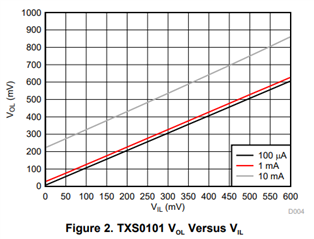Other Parts Discussed in Thread: TXB0102, SN74AVC2T245, SN74AXC2T245, SN74AXC2T45, SN74AXC4T245, 2N7001T, SN74AXC1T45
Hi there,
After reading the comments and specs of TXS0102, sitll have something need to be clarified.
First is about the relationship between Vol & Vil. As I know from the spec, the Vol equals to Vil + Vdrop of pass-gate transistor, and with the following figure in document "Factors Affecting VOL for TXS and LSF Auto-bidirectional Translation Devices".

In the figure, is the current the one crossing the pass-gate transistor? how can I estimate the possible current value might be in my design? Is the figure the same if it comes to TXS0102?
Can you also indicate what is typical value of this current value? (in normal case)
Also want to check about TXB0102, in the datasheet it only mention Vil value and partial Vol value as below, most of Vol information is missing. Can you help provide the value?
Furthermore, at here the test condition is at IOL = 20uA case, can we take it as a normal condition, for both TXS & TXB series? Again, how's it be considered and calcuated?


I'm asking this because now we encounter an part selecting issue with following design flow:

We're evaluating the potential risks if we use TXS0102 or TXB0102 in the design.
Thanks a lot in advance!
Tim

